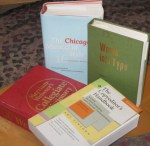There’s a lot of gobbledygook out there about “the writer’s voice,” also known as “the author’s voice.” Writers worry about finding their voice, and about not finding it, and about not knowing whether they’ve found it or not.
Copyeditors worry about interfering with the author’s voice, often without being too clear on what an author’s voice is, what a particular author’s voice sounds like, and when it’s OK to mess with it.
Agents and acquisitions editors often claim that it’s the writer’s voice that lifts a manuscript from the slush pile and into the elite ranks of the Traditionally Published. What exactly do they mean by that?

When I hear writers talk about finding their voices, this is the image that comes to mind: “His Master’s Voice,” the voice coming out of the record player. Where the hell did my voice go? Who’s talking?
Time to cut through the obfuscation and mystification. Your writer’s voice isn’t something you find, like the prize at the end of a treasure hunt or the pot of gold at the end of the rainbow. It’s something you develop on the journey.
If you’re writing in English, you start with pretty much the same rules and conventions as everybody else. The way you use, abuse, ignore, and stretch those rules and conventions will be influenced by the things you choose to write about, the audience(s) you’re writing for, your traveling companions, the places you pass through and sojourn in, and so on and on.
Think about it: Our speaking voices are flexible. We can whisper or we can shout. The foul-mouthed among us can clean up our language when we’re in polite company or interviewing for a job. Our writing voices can be likewise.
In some kinds of writing, the writer’s individual voice takes a back seat. News reporting, technical writing, scientific writing, the writing in textbooks and legal documents: these don’t generally show much personality. They’re not supposed to. They’re supposed to communicate clearly and, often, concisely. The writers write and the editors edit with this in mind. It takes tremendous skill to do this well.
Note, however, that some lawyers and academics write novels, journalists write memoirs, business people write poetry, and scientists write essays for the popular press. The novels don’t sound like legal briefs, the memoirs don’t sound like front-page news stories, the poems don’t sound like annual reports, and the newspaper op-eds don’t sound like scientific papers, even though they’re written by the same person.
Even though the writers are almost certainly applying the skills they’ve developed in one milieu to the writing they’re doing in another.

My malamute, Travvy, has a flexible voice. Here he is trying to persuade a tractor to move.
These writers have flexible voices that can be adapted to different kinds of writing. I know a bit about this because over the years I’ve written reviews, essays, poems, news stories, op-eds, newspaper features, short stories, one-act plays, and a novel, not to mention something like 500 blog posts. Some forms I’m more comfortable with than others, some I’m better at than others, but they’re all coming out of the same well of words, opinions, and experiences that is contained in my brain.
Flexibility is especially important for fiction writers and writers of “creative nonfiction” — which seems to mean by definition nonfiction that encourages a distinctive authorial voice. Characters speak in different voices, and all those voices come out of the writer’s head.
The writers of memoir and travelogue often have occasion to quote actual people. This requires first the ability to listen attentively and then the ability to translate the other person’s voice onto the printed page. Sometimes this means putting words in the other person’s mouth that the other person never said. If the other person is dead or fictitious, he or she won’t sue for libel — but astute readers often know when a character steps out of character. When the lapse is obvious enough, the reader may lose confidence in the character, the story, and the author.
My editorial diet is similarly varied. Most of it is nonfiction, but it ranges from scholarly books and dissertations to memoirs, essay collections to book-length works by journalists. Most of the novels I edit are stand-alones: they aren’t part of a series, and they don’t belong to a recognizable genre. Each genre and kind of writing has its own conventions and its own objectives, and in most cases some flexibility is allowed — even encouraged.
In the early pages and chapters — I work primarily on book-length works — I listen for the author’s voice. Sometimes it’s distinctive; often it’s fairly subtle. I notice the words and constructions that the author is particularly fond of. These are perfectly OK in themselves, but used to excess they can become cloying. Some authors (like me) like long sentences and write them well, but that doesn’t mean that the occasional long sentence doesn’t get tangled enough to trip even a careful reader up.
I do this pretty much without thinking. If you asked me at the end of a job to describe the author’s voice, I’d have a hard time doing it — until I went back with a more analytical eye and identified the various components that make up the author’s style. As a result, I can be a little suspicious when agents, acquisitions editors, and writing teachers go on and on about the importance of that mystical, mystifying entity, “the writer’s voice.”
A few weeks back, though, I was reminded of just how important a writer’s voice can be. A writer I didn’t know asked me to critique his just-completed novel. Like many another editor upon receiving a similar request, I was wary. Most such manuscripts turn out to need serious work before they become publishable, or even readable. “Serious work” translates into serious time, which means serious money. The writer doesn’t have it, or doesn’t want to spend it, and I can’t afford to work for nothing.
So I asked to see a chapter or two. I was already bracing myself for frustration.
Then I started reading. Sure, the punctuation needed work and some of the word choices were a little off, but it was clear almost immediately that the author was one hell of a storyteller and that he had one hell of a story to tell.
Send me the whole thing, I said.
Since then that storyteller’s voice has conjured scenes I couldn’t imagine, taken me places I didn’t want to go, and made me laugh at the same time. This voice isn’t my voice, but it’s so strong and distinctive that I’ve had no trouble slipping inside it and hearing it while I meddle with the punctuation, rearrange the occasional sentence, and ask questions about things that aren’t clear.
Editing doesn’t get much better than this.
When this novel makes it into print, you will hear about it. I promise.




 On to the manuscript itself. I am accustomed to electronic editing, so in order for me to work with Jane’s extensive comments, I transcribed the first 64 pages of her penciled notes from the paper copy to my computer. Once I got that far, I decided I’d better stop there and write my own comments. The first 153 edits took me up to page 58. Of the 153, I accepted three and rejected 150. I explained each and every one of the 150 I rejected.
On to the manuscript itself. I am accustomed to electronic editing, so in order for me to work with Jane’s extensive comments, I transcribed the first 64 pages of her penciled notes from the paper copy to my computer. Once I got that far, I decided I’d better stop there and write my own comments. The first 153 edits took me up to page 58. Of the 153, I accepted three and rejected 150. I explained each and every one of the 150 I rejected.

